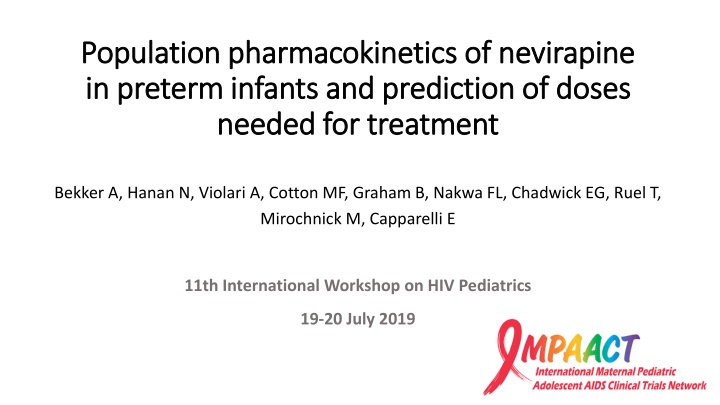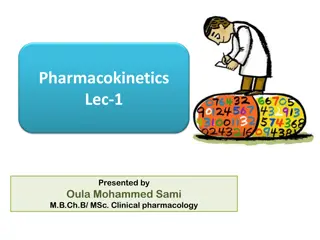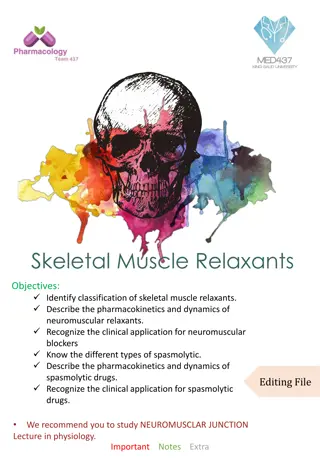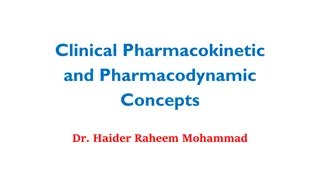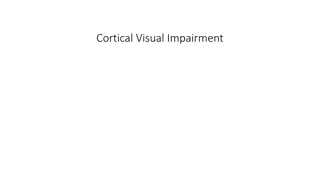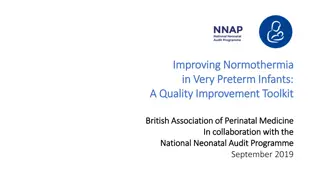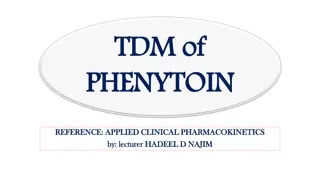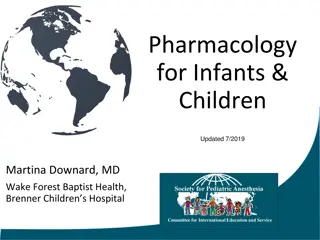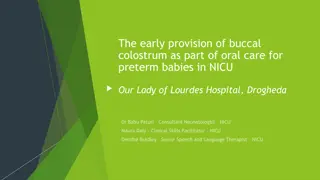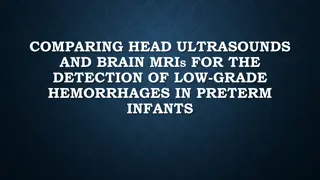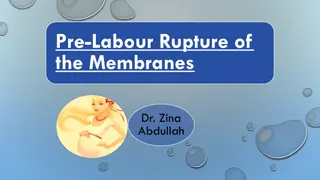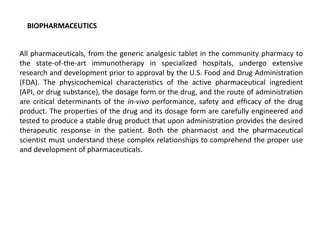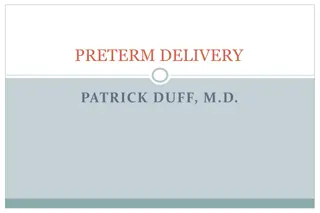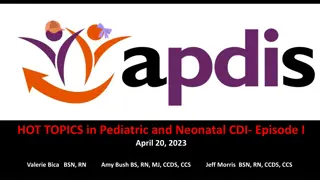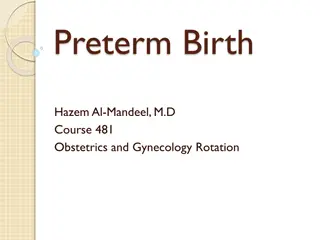Population Pharmacokinetics of Nevirapine in Preterm Infants
Population pharmacokinetics of nevirapine in preterm infants were evaluated to predict the doses needed for treatment. Early antiretroviral treatment recommendations for neonates, challenges with available ARV formulations, and the importance of data to inform nevirapine dosing in preterm infants were discussed, highlighting the variability in target concentrations and the impact of reduced clearance in this population.
Download Presentation

Please find below an Image/Link to download the presentation.
The content on the website is provided AS IS for your information and personal use only. It may not be sold, licensed, or shared on other websites without obtaining consent from the author.If you encounter any issues during the download, it is possible that the publisher has removed the file from their server.
You are allowed to download the files provided on this website for personal or commercial use, subject to the condition that they are used lawfully. All files are the property of their respective owners.
The content on the website is provided AS IS for your information and personal use only. It may not be sold, licensed, or shared on other websites without obtaining consent from the author.
E N D
Presentation Transcript
Population pharmacokinetics of nevirapine Population pharmacokinetics of nevirapine in preterm infants and prediction of doses in preterm infants and prediction of doses needed for treatment needed for treatment Bekker A, Hanan N, Violari A, Cotton MF, Graham B, Nakwa FL, Chadwick EG, Ruel T, Mirochnick M, Capparelli E 11th International Workshop on HIV Pediatrics 19-20 July 2019
Early antiretroviral treatment (ART) in neonates Early antiretroviral treatment (ART) in neonates Rapid initiation of ART from birth is recommended for neonates HIV-infected and high risk of HIV acquisition Early ART in this population is hampered by neonatal antiretroviral (ARV) formulations and lack of dosing information The only available options for a 3-drug ARV regimen from birth are: NVP and ZDV/3TC or RAL and ZDV/3TC
Antiretroviral (ARV) formulations for use in neonates Antiretroviral (ARV) formulations for use in neonates ARV Term Preterm Comments Nevirapine (NVP) X (X) only for prevention Raltegravir (RAL) X Challenging granule formulation Limited availability Lopinavir/ritonavir (LPV/r) Zidovudine (ZDV) X Only > 2 weeks PNA and After 42 weeks PMA only X X Lamivudine (3TC) X https://aidsinfo.nih.gov/
Antiretroviral (ARV) formulations for use in neonates Antiretroviral (ARV) formulations for use in neonates ARV Term Preterm Comments Nevirapine (NVP) X (X) prevention treatment prevention Raltegravir (RAL) X Challenging granule formulation Limited availability Lopinavir/ritonavir (LPV/r) X Only > 2 weeks PNA and After 42 weeks PMA only No pharmacokinetic and safety data available for nevirapine at treatment doses in preterm infants Zidovudine (ZDV) X X Lamivudine (3TC) X https://aidsinfo.nih.gov/
Why do we need data to inform nevirapine Why do we need data to inform nevirapine treatment dosing in preterm infants? treatment dosing in preterm infants? There are different NVP trough target concentrations for prophylaxis (0.1 mcg/mL) compared to treatment (3 mcg/mL) 30-fold difference in target concentration NVP clearance is reduced in preterm infants compared to term infants NVP doses of 4 mg/kg QD in preterm infants consistently had NVP concentrations above the prophylaxis target IMPAACT P1106 study
How can we use modeling to predict the nevirapine How can we use modeling to predict the nevirapine treatment dose in premature infants ? treatment dose in premature infants ? AIM AIM To combine pharmacokinetic data from 2 existing IMPAACT studies (P1106 and P1115) and develop a population pharmacokinetic model (followed by simulations) to determine the appropriate nevirapine treatment dosing in premature infants
IMPAACT studies P1106 and P1115 IMPAACT studies P1106 and P1115 P1106 included premature and low birth weight (<2500g) infants receiving NVP for prevention at 2 different doses Birth- 14 days 2 mg/kg QD 14 days 6 months 4 mg/kg QD Samples from week 1 of age up to week 24 P1115 included premature infants (34 - <37 weeks GA) who received early combination ARV treatment including NVP Birth 7 days 4 mg/kg QD 7 days - onwards 6 mg/kg BID Samples from week 1 of age, with a 2nd collection 1 week later if still on NVP
Baseline characteristics Baseline characteristics In 71 preterm infants - 304 NVP concentrations from 211 study visits Characteristics Median (IQR) P1106 (n=54) Gestational age (weeks) 32 (28-32) Postnatal age (days) Weight (g) 9 1700 (1400-2200) P1115 (n=17) Gestational age (weeks) 36 (35-36) Postnatal age (days) 7 Weight (g) 2600 (2300-3000)
Nevirapine population PK model in preterm Infants Nevirapine population PK model in preterm Infants Gestational age (GA) at birth and postnatal age (PNA) were significant covariates for NVP clearance (CL) Population pharmacokinetic parameters Vd (L/kg) = 3.39 CL/F (L/h/kg0.75) = 0.117*(GA/34)9.97*(1-MAT) *(MAT) Where MAT is a maturation function described by PNA/(13.5 days + PNA) Between subject variability (BSV) V/F =75% CL/F = 64% V-CL correlation 53% High BSV in preterm infants - maturing at different rates - absorption differences
Population PK model predicts excessive NVP Population PK model predicts excessive NVP concentrations in preterm infants given the standard concentrations in preterm infants given the standard treatment dose treatment dose NVP treatment dose for term neonates is 6 mg/kg BID 30 Mean NVP conc (mcg/mL) 24 Mean NVP Conc (mcg/mL) 18 Term Term 6 mg/kg BID Preterm (28WK) Preterm (28 weeks) 12 6 NVP trough target concentrations > 3 mcg/mL for treatment 0 0 7 14 21 28 Post Natal Age (Days) Postnatal age in days
Simulated NVP concentrations in various GA groups Simulated NVP concentrations in various GA groups 12 Mean NVP conc (mcg/mL) Using a proposed dosing strategy of 1.5 - 6 mg/kg BID with increases at 2 week intervals GA28 GA 28 GA 29.9 GA29.9 9 Mean NVP Conc (mcg/mL) GA30 GA 30 GA 32 GA32 6 GA33.9 GA 33.9 GA 34 GA34 3 GA40 GA 40 NVP trough target concentrations > 3 mcg/mL for treatment 0 0 7 14 21 28 35 42 Post Natal Age (Days) Postnatal age in days Each line represents the mean NVP trough concentrations for a typical patient at that exact GA using our proposed BID dosing strategy
NVP population PK treatment doses for preterm Infants NVP population PK treatment doses for preterm Infants BID dosing strategy BID dosing strategy 2 weekly increase in dosing 2 weekly increase in dosing For GA 28 to < 30 weeks 1.5 mg/kg 2 mg/kg 4 mg/kg 6 mg/kg Birth 13 days PNA For GA 30 to < 34 weeks 14 days 27 days PNA 2 mg/kg 28 days 41 days PNA 4mg/kg 42 days PNA 6 mg/kg Birth 13 days PNA For GA 34 to < 38 weeks 14 days 27 days PNA 4mg/kg 14 days 27 days PNA > 28 - 42 days PNA 6 mg/kg 28 -42 days PNA 12 GA28 GA29.9 9 Mean NVP Conc (mcg/mL) GA30 GA32 6 GA33.9 GA34 3 GA40 0 0 7 14 21 28 35 42 Post Natal Age (Days)
Conclusions Conclusions Excessive NVP concentrations are predicted in preterm infants given the standard treatment dose (6 mg/kg BID) Based on the simulations, we recommend a lower NVP BID dosing strategy for preterm infants (< 34 weeks GA) requiring NVP treatment In future, we will be studying the pharmacokinetics and safety of NVP at treatment dose in premature infants IMPAACT P1106
Acknowledgements Acknowledgements IMPAACT P1106 and P1115 study teams Adrie Bekker, MBChB/ Vice Chair Mark Cotton, M.Med/Co-Chair Mark H. Mirochnick, M.D. /Co-Chair Edmund Capparelli, Pharm.D. Renee Browning/DAIDS MO Jack Moye/NICHD MO Katie McCarthy, MPH/CTS Emily Brown, MA/CTS Bobbie Graham, B.A/Data Manager Yvonne Bryson, M.D. / Co Chair Ellen Chadwick, M.D. / Co Chair Mark Cotton, M.Med/Vice Chair Mark H. Mirochnick, M.D. Edmund Capparelli, Pharm.D Edward Acosta, Pharm.D. Patrick Jean-Phillippe, MD/DAIDS MO Rohan Hazra, M.D./NICHD MO Anne Coletti, M.S/CTS Bonnie Zimmer, B.S./Data Manager Overall support for the IMPAACT was provided by the National Institute of Allergy and Infectious Diseases (NIAID) with co-funding from the Eunice Kennedy Shriver National Institute of Child Health and Human Development (NICHD) and the National Institute of Mental Health (NIMH), all components of the National Institutes of Health (NIH), under Award Numbers UM1AI068632 (IMPAACT LOC), UM1AI068616 (IMPAACT SDMC) and UM1AI106716 (IMPAACT LC), and by NICHD contract number HSN275201800001
Simulated concentration profiles Simulated concentration profiles GA of < 34 weeks GA of < 34 weeks with BID dose with BID dose increases at 2 week intervals increases at 2 week intervals 12 12 GA = 34 weeks Mean NVP conc (mcg/mL) GA < 34 weeks Mean NVP conc (mcg/mL) 9 9 GA33.9 GA33.9 6 6 GA34 3 3 0 0 0 7 14 21 28 35 42 0 7 14 21 28 35 42 Postnatal age in days Postnatal age in days 2 mg/kg At birth 4mg/kg 6 mg/kg 14 days postnatal age 28 days postnatal age
Simulated concentration profiles Simulated concentration profiles GA of < 30 weeks GA of < 30 weeks with BID dose with BID dose increases at 2 week intervals increases at 2 week intervals Mean NVP conc (mcg/mL) Mean NVP conc (mcg/mL) 12 12 GA < 30 weeks GA = 30 weeks 9 9 GA29.9 GA29.9 6 6 GA30 3 3 0 0 0 7 14 21 28 35 42 0 7 14 21 28 35 42 Postnatal age in days Postnatal age in days 1.5 mg/kg At birth 2 mg/kg 4 mg/kg 6 mg/kg 14 days postnatal age 28 days postnatal age 42 days postnatal age
